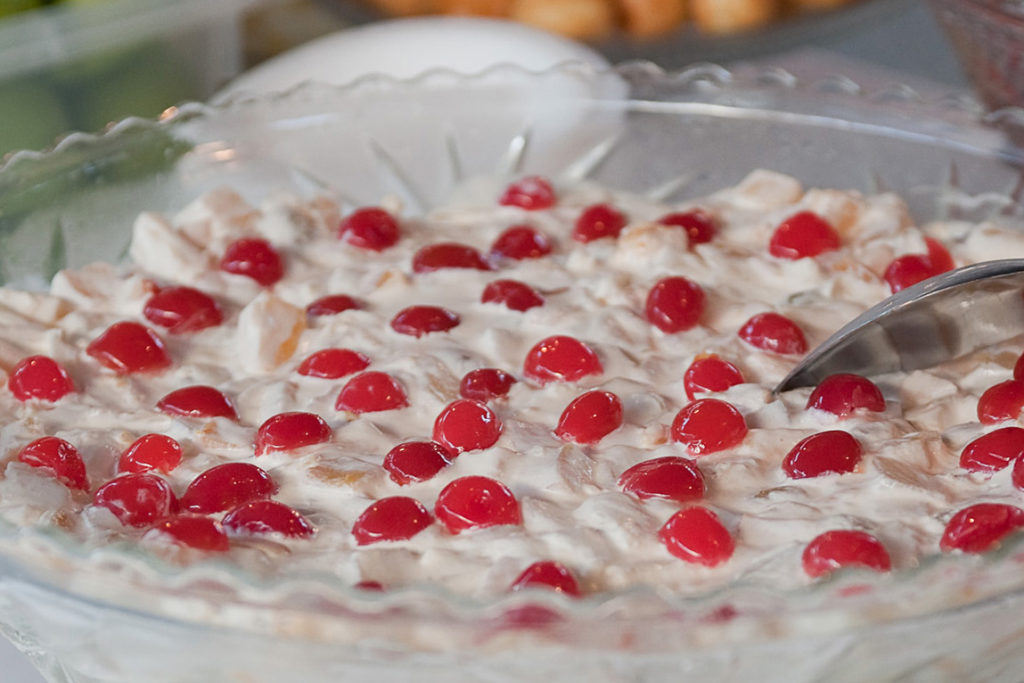
Description
A sweet mixture of various fruits in a thick sweet cream.
History
Origin
The concept of fruit salad was probably introduced during the US Naval Era, perhaps in the early 1900s. While ancient CHamorus ate mangoes, papayas, young coconuts (månha), bananas and other native fruits, the mixing of a variety of fruits with a sweet sauce is distinctly Western.
Fruit salad as it is known today (a mixture of fresh fruits, canned fruits and sweetener) comes from the mid 1800s. There are several forms of fruit salads that use mayonnaise (Waldorf fruit salad) that is popular in Europe; or oranges and sour cream (Ambrosia) popular in America; and others that use coconut and condensed milk, popular in the Philippines and Guam.
Evolution
Typical fruit salads of the 1950s relied heavily on canned fruit cocktail as the base, and was mixed with sweetened mayonnaise, whipped cream, sweetened sour cream, and/or marshmallows. Local additions included chunks of available fruit such as bananas, papayas, and mangoes. Maraschino cherries are often added for color and sweetness. One of the earliest, favorite fruit salads of the 1950s was prepared by Isabel LG Cruz of Inalåhan, who added fresh heart-of-palm to her dish. Contemporary fruit salads have a large variety of local and imported fruits and an equally large variety of sauces. Also popular on today’s fiesta table are blends of fresh and frozen fruits in their own juices without a sauce added. These fruit compotes are not included in this definition of fruit salad.
Preparation
A combination of canned, frozen and fresh fruits are assembled and chilled. The blend of these ingredients, together with the particular sauce added, creates each unique salad. The sauce is added to the chilled, drained fruits, and placed in a large, glass serving bowl.
Placement on table
Fruit salad is placed with other desserts, either at the end of the main table, or on a separate, dessert table. It is usually contained in a large bowl, with a large spoon to scoop a portion into disposable cups arranged next to the bowl.
Recipe
Fruit Salad with fresh fruit
- 2-12 ounce cans tropical fruit cocktail
- Melon
- Cantaloupe
- Papaya
- Mango
- Banana
- 12 ounce jar coconut gel
- 12 ounce jar makapuno (coconut sport), or fresh månha (young coconut meat) pieces
- Laguana (soursop – annona muricata)
- ¼ cup honey
- Miniature marshmallows, optional
For a sweeter mix use:
- Sour cream
- Honey
- Whipped cream
This recipe is just one of an unlimited variety of fruit salad concoctions. The focus of this recipe is to feature the flavor of local fruits in the selected fruits as well as in the sauce. The following will make enough fruit salad to fill a 6 quart bowl. Increase all ingredients to make larger portions. Start with two 12 ounce cans of chilled, drained tropical fruit cocktail. Remove the skin and add bite-size chunks of local melon, cantaloupe, firm papaya, firm mango, and sliced banana. Add a 12 ounce jar of prepared, drained coconut gel, which comes in little firm squares or in round gels. A 12 ounce jar of drained coconut sport (makapuno), or fresh månha (young coconut meat) pieces may also be added.
For the sauce, remove the skin and seeds from one medium or large, ripe laguana (soursop – annona muricata). In a blender, combine the white, fleshy meat with ¼ cup of honey. Mix this sauce with the chilled fruits to create a creamy, light sauce. For those who prefer a heavier, sweeter sauce, sour cream and honey or whipped cream may be substituted. Miniature marshmallows can always be added.
*Recipe by Judy Flores, PhD
